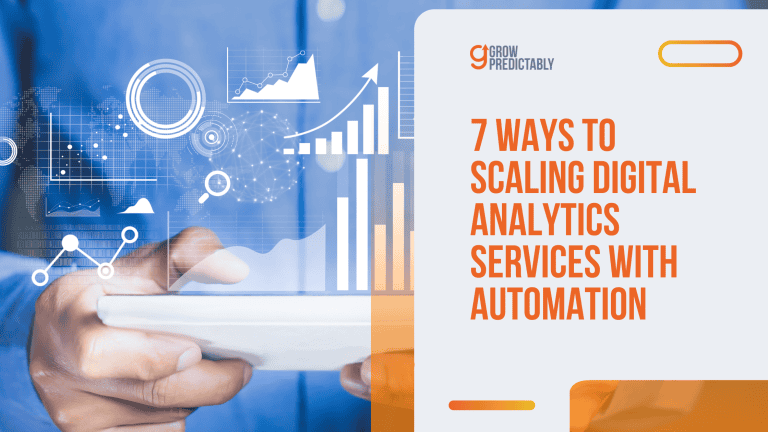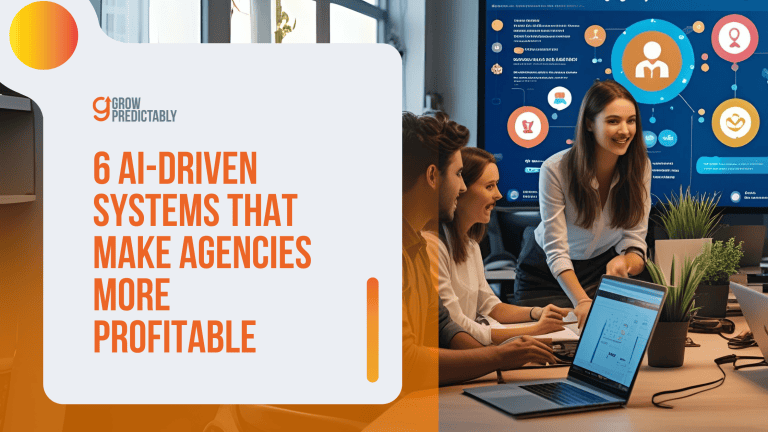The Ultimate Guide to B2B Lead Generation for Digital Marketing Agencies in 2025
Here’s the lie: more leads = more clients.
Truth is, every bloated pipeline filled with unqualified prospects just burns resources.
In 2025, b2b lead generation for digital marketing agencies isn’t about volume—it’s about precision.
Decision-makers want relevance, personalization, and proof—fast.
Agencies ignoring that are bleeding opportunities.
But others?
They’re zeroing in on what works—and converting 3x faster using AI-backed signals [DemandGen Report, 2024].
Want to know what they’re doing that you’re not?
Keep on reading!
Why B2B Lead Generation in 2025 Demands a New Approach
The lead generation process starts by finding out where your target market ‘lives’ on the web.”
Wayne Davis
The playbook that worked last year is dead.
Every day, I talk to agency owners who keep throwing money at outdated lead gen tactics while their competitors eat their lunch.
According to a recent study by Forrester Research, 71% of B2B buyers now conduct more than half their research online before ever contacting a sales rep, completely changing how purchase decisions happen.
The landscape has fundamentally changed.
Privacy walls are up.
Decision-making committees have ballooned.
And clients demand quality over quantity.
A marketing agency requires tailored strategies for lead generation, blending creativity with systematic planning to design effective landing pages and implement lead generation funnels.
The Current State of B2B Lead Generation
Marketing budgets are getting slashed while growth expectations remain sky-high.
According to Gartner’s 2024 CMO Spend Survey, 47.7% of marketing teams faced reduced budgets in the last 12 months.
Yet they’re still expected to deliver more leads, more customers, and more revenue.
This isn’t just a minor inconvenience—it’s a fundamental shift in how we have to approach lead generation.
Effective lead generation tools are essential for achieving efficiency and managing leads effectively, enabling businesses to scale their client acquisition efforts through automation and data integration.
Digital marketing agencies find themselves in a brutal position: deliver measurable results with fewer resources or get replaced.
The math doesn’t add up, but that’s the reality we’re facing.
Your clients don’t care about your budget constraints—they care about results.
This means you need to get surgical about where you invest your time and money, focusing exclusively on strategies that deliver the highest return with minimal waste.
- Look at your current lead generation channels and rank them by cost-per-qualified-lead, not just volume
- Identify micro segments within your target market that have the highest conversion rates and double down on them
- Eliminate any marketing activities that can’t be directly tied to pipeline generation or revenue
- Implement attribution modeling that goes beyond first-touch or last-touch to understand the true impact of each channel
The agencies that will thrive in this environment aren’t the ones with the biggest budgets—they’re the ones who can extract maximum value from every dollar spent.
This requires a fundamental shift from “more marketing” to “better marketing” with relentless focus on efficiency.
Key Challenges Facing Digital Marketing Agencies
The numbers tell a brutal story: 45% of businesses struggle to generate enough leads, while 42% can’t solve their lead quality issues, according to HubSpot’s State of Inbound Marketing Trends report.
This isn’t just a minor obstacle—it’s an existential threat to your agency’s survival.
What worked in 2023 is already failing, and what works today will be ineffective by next quarter.
The lead generation landscape is shifting beneath our feet.
Agencies face a dual challenge: they must solve these problems for themselves while simultaneously delivering solutions for their clients.
- Rising acquisition costs across paid channels have increased by 60% over the past five years, according to WordStream
- Cookie deprecation and privacy changes have decimated targeting capabilities on platforms that previously delivered reliable results
- AI-generated content has created unprecedented noise levels, making it harder to get prospects’ attention
- Declining organic reach across social platforms forces more investment in paid promotion for the same results
Sales teams can help overcome these challenges by identifying sales triggers and nurturing leads to build relationships and trust, which is crucial for improving account-based marketing strategies.
The brutal truth is that most agencies are applying outdated methodologies to new problems.
If you’re still relying on the same lead generation playbook from 2022, you’re already behind.
The agencies that survive will be those that relentlessly test new approaches, rapidly abandon what isn’t working, and scale what delivers results—regardless of whether it fits their preconceived notions of what “should” work.
The Buyer’s Journey in 2025
The B2B buying process has become dramatically more complex.
Research from Gartner reveals that over 20% of businesses now have six or more people in their decision-making unit (DMU) [https://www.gartner.com/en/sales/insights/b2b-buying-journey].
This isn’t just a small increase—it’s a fundamental restructuring of how purchase decisions happen.
Each stakeholder brings their own priorities, objections, and decision criteria to the table.
The technical evaluator cares about features and implementation details.
The financial buyer focuses on ROI and cost justification.
The end-user prioritizes usability and workflow integration.
And the executive sponsor wants strategic alignment and competitive advantage.
- Map the specific information needs for each stakeholder at every stage of the buying process
- Develop targeted content that addresses the unique concerns of each DMU member
- Create tools that help champions sell internally to other stakeholders
- Implement account-based strategies that engage multiple contacts simultaneously
Engaging with key decision makers within target companies can streamline negotiations and facilitate the conversion of leads, particularly through tailored communication strategies.
The old linear sales funnel is dead.
Today’s reality is a complex web of interactions between multiple stakeholders, each following their own non-linear path.
Your lead generation strategy must account for this complexity, delivering the right message to the right person at the right time—while maintaining a coherent narrative across all touchpoints.
Your ability to navigate this complexity will determine whether you close deals or watch opportunities stall indefinitely in the “considering” phase.
This isn’t optional—it’s the new standard for B2B lead generation success in 2025.
Foundational Strategies for B2B Lead Generation Success
Let’s be real.
If you’re struggling to get leads right now, it’s not because you’re missing some secret hack.
Success today means building a solid base that won’t fall apart when things get tough.
Effective lead generation strategies are vital for sustaining business growth in a competitive market.
The winners aren’t using magic tricks—they’re just doing the basics really well.
Creating an Effective B2B Lead Generation Framework
You need a plan, not random tactics thrown together.
Start by clearly defining what makes a good lead for marketing versus a good lead for sales. Aligning your marketing efforts with your sales team is crucial for better lead management and conversion.
Without this clarity, you’re just shooting in the dark.
Research shows companies with clear lead frameworks convert 73% more prospects into opportunities.
This isn’t just nice to have—it’s essential.
Don’t get distracted by numbers that look good but don’t translate to actual sales.
- Create scoring rules based on real buying signs, not just who clicked your email
- Get marketing and sales to agree in writing about when leads get passed along
- Track which leads actually become customers so you can improve your approach
- Set up systems that nurture people who aren’t ready to buy yet
Here’s the truth: your framework becomes useless if it’s too rigid.
The best plans evolve as you learn more about how your customers actually make decisions.
Aligning Sales and Marketing Teams
You can’t afford to have sales and marketing working separately anymore.
When these teams aren’t on the same page, you’re wasting money and missing opportunities every day.
The stats are clear—businesses with aligned teams win 38% more deals and keep 36% more customers.
But a few joint meetings won’t fix this.
You need to rethink how these teams work together from the ground up.
Sales enablement tools are crucial in facilitating lead generation and engagement, helping to effectively reach and nurture ideal customers.
- Set goals that make both teams focus on revenue, not just activities
- Have sales and marketing plan target accounts together
- Make sure sales feedback directly shapes what content gets created
- Reward people for helping each other succeed, not just hitting personal targets
The old way of marketing getting leads and “throwing them over the fence” to sales doesn’t work anymore.
The top performers now have unified teams that share responsibility for the entire customer journey.
Identifying and Targeting Ideal Client Profiles
If you try to appeal to everyone, you’ll end up connecting with no one.
Your message needs to be spot-on, and that starts with knowing exactly who you’re talking to.
Data proves it—companies with clear target profiles win 68% more accounts.
Your ideal client profile isn’t just basic company info.
It’s a complete picture of businesses where you can truly solve problems.
Understanding the job title of your prospects is crucial for tailoring marketing strategies and content to effectively address their needs and pain points.
In today’s world, sending the same message to everyone is a luxury you can’t afford.
- Look at your best clients and spot the patterns—what makes them different?
- Go beyond just industry and size—what triggers make them ready to buy?
- Make a “not a good fit” list that’s as detailed as your target list
- Keep refining what you know with every new conversation
Let me be straight with you: trying to be all things to all people doesn’t work anymore.
The agencies crushing it right now have narrowed their focus, becoming experts who understand specific clients so well that competitors can’t keep up.
Advanced B2B Lead Generation Strategies for 2025
Don’t optimize for conversions, optimize for revenue.”
Neil Patel
It’s time to go beyond the basics and leverage what’s actually working right now.
The landscape has shifted dramatically, and these proven approaches are delivering results for agencies that implement them properly.
Nurturing leads generated through lead generation marketing by implementing strategies that focus on identifying sales triggers and building relationships is crucial for success.
Content Marketing Excellence
Content marketing dominates demand generation, with 87% of marketers reporting it as their most effective tool, up 11% from 2024.
Video content leads the pack with 58% of B2B marketers citing it as their top-performing format.
The days of generic blog posts and surface-level white papers are over.
Today’s buyers expect deep, specific content that addresses their exact situation.
Your competitors are creating specialized content for each buying stage and stakeholder role.
You need multi-format assets that address specific pain points and objections at each stage of the buyer’s journey with engaging content.
- Shift from quantity to quality with fewer, deeper, more actionable assets
- Create modular content that sales can customize for specific prospects
- Invest in video formats that showcase real results, not just features
- Build decision-support tools that help prospects make their case internally
The content winners in 2025 are creating fewer pieces with much higher value—pieces that actually help buyers make decisions rather than just generating awareness.
Account-Based Marketing (ABM) Implementation
ABM delivers unmatched ROI with 87% of businesses reporting it as their highest-ROI strategy.
Personalized ABM campaigns achieve 50% higher engagement and 30% shorter sales cycles, making this approach essential for agencies targeting high-value clients.
ABM isn’t just a tactic—it’s a complete shift in how you approach the market.
Instead of casting a wide net and hoping for the best, you’re identifying specific companies that are ideal fits and pursuing them with laser focus.
Clearly articulating the unique value proposition in ABM campaigns is crucial to demonstrate the services’ effectiveness and potential return on investment.
This approach aligns perfectly with tighter marketing budgets since you waste less on poor-fit prospects.
- Start small with 10-20 target accounts and prove the model before scaling
- Create account-specific landing pages that speak directly to each company’s challenges
- Coordinate outreach across channels (email, social, ads, direct mail) for maximum impact
- Develop account intelligence systems to track buying signals at target companies
The most effective ABM programs don’t just change marketing tactics—they transform how sales and marketing collaborate on specific accounts with shared goals and metrics.
LinkedIn-Focused Social Selling
44% of marketers name LinkedIn as the most effective B2B social platform.
Companies using LinkedIn Sales Navigator see 45% faster lead qualification and 33% higher close rates, indicating the platform’s continued dominance in the B2B space.
LinkedIn has evolved from a simple professional network to the central hub of B2B decision-making.
While other platforms fight for attention, LinkedIn has doubled down on features specifically designed for B2B prospecting and relationship building.
Your presence here isn’t optional—it’s where your buyers are researching solutions.
- Train your team on strategic commenting that demonstrates expertise without pitching
- Build a content calendar that positions your people (not just your brand) as thought leaders
- Use Sales Navigator to monitor buying signals and track decision-makers at target accounts
- Leverage employee advocacy to amplify your reach through authentic personal voices
The most successful LinkedIn strategies blur the line between personal branding and company marketing, creating a network effect that dramatically expands reach without increasing spend.
Additionally, using social media posts as a promotional tool for lead magnets can effectively share valuable resources in exchange for contact information.
Tracking the leads generated from these posts is crucial to refine future marketing strategies.
Email Marketing Optimization
Despite new channels emerging, email marketing persists as a powerful tool, with 44% of B2B marketers ranking it as their #1 lead generation channel.
The key is personalization, as personalized campaigns outperform generic emails by 26% in conversion rates.
Email remains the only channel where you own the relationship completely. It’s not subject to algorithm changes or platform restrictions.
The nurturing process is crucial in email marketing strategies to build trust and establish credibility with potential clients.
But today’s effective email strategies bear little resemblance to the mass blasts of the past.
Modern email success requires sophisticated segmentation, triggered sequences, and content tailored to specific buyer actions.
- Implement behavioral triggers based on website activity and content consumption
- Design mobile-first templates that deliver value instantly on any device
- Test plain-text, conversational formats against designed templates for each segment
- Create buyer-stage specific sequences that align with their research process
The emails that drive results today feel less like marketing and more like personalized guidance from a trusted advisor who understands exactly what the buyer needs next.
Technology and AI in B2B Lead Generation
The tech stack you choose today will either multiply your team’s effectiveness or become your biggest bottleneck.
In 2025, the right technology isn’t just helpful—it’s the difference between scaling profitably and struggling to keep up.
Utilizing effective lead generation tools can significantly enhance your B2B lead generation strategies by automating processes, integrating data, and creating compelling content that attracts and converts high-quality leads.
AI-Driven Personalization and Predictive Analytics
An emerging trend in B2B marketing for 2025 is the increased integration of artificial intelligence for hyper-personalization and predictive analytics.
AI enables agencies to analyze vast datasets in real-time, tailoring content and recommendations with unprecedented accuracy.
The days of one-size-fits-all campaigns are over.
78% of high-performing marketers now use AI-powered tools to deliver personalized experiences at scale.
These aren’t just small tweaks—they’re completely different experiences based on each prospect’s behavior, industry, role, and stage in the buying process.
Continuous optimization is crucial in refining and improving lead generation strategies to increase conversion rates and overall client satisfaction.
- Implement intent data platforms that signal when prospects are actively researching solutions
- Deploy content recommendation engines that suggest the next best resource based on consumption history
- Use predictive lead scoring that identifies which prospects are most likely to convert
- Adopt conversational AI that qualifies leads before human follow-up
The AI advantage comes from handling complexity no human team could manage—creating thousands of personalized experiences while continuously learning which approaches drive the best results.
Marketing Automation and CRM Integration
Utilizing CRM systems and marketing automation tools helps manage lead data efficiently, ensuring personalized and timely interactions.
A well-functioning sales pipeline is crucial for converting leads into customers and ensuring business success.
The integration of these tools creates a seamless lead management ecosystem.
Your tech stack is only as strong as the connections between systems.
Companies with tightly integrated martech stacks generate 23% more leads and close deals 40% faster than those with disconnected tools.
The data has to flow seamlessly across platforms to create a single view of each prospect’s journey.
- Map the entire lead-to-revenue process and identify every point where data transfers between systems
- Implement bi-directional sync between your CRM and marketing automation platform
- Create centralized dashboards that combine data from multiple sources for unified reporting
- Establish clear data governance rules to maintain consistency across platforms
The most successful agencies aren’t necessarily using more tools—they’re getting more from fewer tools by ensuring they work together perfectly.
Preparing for a Cookieless Future
The decline of third-party cookies is pushing B2B marketers to find new approaches to collect first-party data while respecting privacy.
Implementing privacy-focused identifiers and consent management platforms is essential for regulatory compliance.
This isn’t just another technical challenge—it’s a fundamental shift in how we identify and track prospects.
Companies that build first-party data strategies now will have a massive advantage when third-party cookies disappear completely.
Those who don’t will see their targeting capabilities collapse overnight.
Analyzing prospects’ needs, including opportunities for improving organic traffic, can inform outreach strategies and help agencies offer targeted support.
- Create value exchanges that motivate prospects to willingly share their information
- Develop contextual targeting strategies that don’t rely on individual tracking
- Implement server-side tracking solutions that respect privacy while preserving analytics capabilities
- Build partnerships that allow for secure data sharing within privacy regulations
The winners in this new landscape won’t be those who find sneaky workarounds—they’ll be the ones who rebuild their approach around transparent value exchanges and first-party relationships.
Creating High-Converting Lead Magnets
Your ultimate weapon in creating a highly converting lead magnet is to create it so that the minions can understand it. Get their attention and they will flag it up to Gru for that sweet, sweet active attention.”
Kenda Macdonald
The right lead magnet can single-handedly transform your lead generation results.
But in 2025, the bar has been raised—generic PDFs won’t cut it anymore.
Incorporating expert endorsements and personalized content into your marketing materials can significantly enhance credibility and searchability for B2B brands.
You need to create something truly valuable that stands out.
Effective Lead Bait Development
Creating high-converting lead bait (like ebooks, webinars, whitepapers, and challenges) is fundamental to a successful lead generation strategy.
These assets should directly address specific pain points in your target market.
The best lead magnets solve real problems that keep your prospects up at night.
Research shows that problem-solving content converts 300% better than purely educational material.
Your lead magnet needs to deliver instant value while positioning your solution as the logical next step.
Using lead gen forms can significantly enhance the lead generation process by allowing users to complete forms directly on platforms like LinkedIn, eliminating the need to navigate to external landing pages.
- Create lead magnets for specific buying stages, not generic catch-all resources
- Focus on immediate application—what can they implement today for a quick win?
- Design lead magnets that showcase your unique methodology or approach
- Test different formats (calculators, assessments, templates) against traditional PDFs
The most effective lead magnets don’t just inform—they transform.
They give prospects a taste of the results they’ll get by working with you, creating demand for the full solution.
Content Types That Drive Lead Generation
Interactive content boosts engagement by 34% compared to static materials.
Case studies convert 72% of leads in consideration stages, while webinars generate 40% of qualified leads for SaaS companies.
The format of your content matters just as much as what it says. Creating engaging content is crucial for boosting engagement and driving lead generation.
Today’s buyers have seen thousands of generic PDFs and webinars.
They’re hungry for content that engages them actively and delivers personalized insights based on their situation.
- Build interactive assessments that give prospects a customized analysis of their needs
- Create comparison tools that help buyers evaluate different solutions against their criteria
- Develop guided calculators that show the financial impact of solving their specific problems
- Design micro-courses that deliver practical skills in bite-sized, actionable lessons
Multi-format content packages perform better than single assets.
Consider creating content bundles that address the same problem through different learning styles and time commitments.
Optimizing Landing Pages for Conversion
84% of marketers leverage on-site form submissions to convert leads.
Creating high-converting landing pages with clear value propositions, compelling CTAs, and streamlined forms significantly impacts conversion rates.
Optimizing landing pages is crucial for improving the conversion rate and enhancing lead generation results.
Your landing page is where theory meets practice—where interest transforms into action.
The best pages focus relentlessly on a single conversion goal, removing every element that doesn’t directly support that action.
Even small improvements here compound over time, dramatically increasing your total lead volume.
- Limit form fields to only what’s absolutely necessary for meaningful follow-up
- Use benefit-focused headlines that emphasize what prospects will gain, not just what they’ll get
- Test specific, action-oriented CTAs against generic phrases like “Submit” or “Download”
- Implement social proof that matches your target audience’s industry and company size
The highest-converting landing pages don’t try to explain everything—they address the key objections that prevent conversion while creating intense curiosity about what’s on the other side of the form.
Multi-Channel B2B Lead Generation Approaches
The best lead generation strategies don’t rely on a single channel—they create a coordinated experience across multiple touchpoints.
Leveraging multiple marketing channels, such as social media, email marketing, and paid advertising, is crucial to maximize reach and engagement.
Your prospects move between channels seamlessly, and your strategy needs to follow them.
Omnichannel Marketing Strategy Development
Multi-channel marketing campaigns achieve a 31% lower average cost per lead than single-channel outreach.
Developing a cohesive strategy across multiple touchpoints ensures maximum reach and engagement.
It’s not just about being everywhere—it’s about creating a consistent journey that builds on itself across channels.
Maintaining a consistent brand message across various marketing channels is crucial to addressing client challenges effectively.
Your prospects don’t think in terms of channels; they experience your brand as a whole.
Each touchpoint should reinforce and extend the others, not exist in isolation.
- Map your customer journey across channels to identify gaps and redundancies
- Implement cross-channel attribution to understand how channels work together
- Create content specifically designed for channel hand-offs (from social to landing page, email to webinar)
- Develop consistent messaging frameworks that adapt to each channel’s unique format
The agencies seeing the best results don’t just launch campaigns in multiple channels—they orchestrate coordinated experiences where each channel plays a specific role in moving prospects forward.
Balancing Inbound and Outbound Tactics
While inbound strategies attract hand-raisers who are already looking for your services, strategic outbound campaigns can proactively target high-value prospects.
The most successful agencies in 2025 employ a hybrid approach.
Inbound lead gen is a crucial strategy where potential clients proactively seek out services through optimized content, enhancing credibility and trust in the brand.
The inbound versus outbound debate is over—the winners use both strategically.
Research shows companies using integrated approaches generate 3x more leads than those relying exclusively on either method.
Your strategy should leverage the strengths of each approach at the right time for the right prospects.
- Use inbound to build authority and capture active buyers cost-effectively
- Deploy targeted outbound to break into high-value accounts that aren’t actively searching
- Coordinate timing so outbound outreach coincides with relevant inbound content releases
- Implement intent monitoring to trigger outbound outreach when prospects show buying signals
Stop thinking of inbound and outbound as separate strategies.
They work best when they reinforce each other—inbound creating familiarity that makes outbound more effective, and outbound driving traffic that boosts inbound results.
Paid Media Strategies for B2B Lead Generation
Strategic investment in paid channels like LinkedIn Ads, Google Ads, and retargeting campaigns can amplify organic efforts and accelerate results, especially when well-timed and precisely targeted.
Paid advertising is a crucial element within various B2B lead generation strategies.
It complements other methods like social media outreach, content marketing, and SEO, offering a way to quickly generate leads despite its potential higher costs and lower conversion rates.
Organic reach has limits.
Paid media lets you scale beyond those limits and reach exactly who you want, when you want.
Companies with sophisticated paid strategies see 2-3x higher growth rates than those relying solely on organic methods. The key is surgical precision in your targeting and messaging.
- Implement account-based advertising that targets specific companies with personalized messages
- Use search ads to capture bottom-funnel demand with high purchase intent
- Deploy retargeting campaigns that nurture prospects based on their specific content consumption
- Test LinkedIn matched audiences to reach decision-makers within target accounts
The most effective paid strategies don’t just drive clicks—they drive the right clicks.
Quality trumps quantity every time, especially when you’re paying for each impression or click.
Measuring and Optimizing B2B Lead Generation Performance
Attention is the new currency. The more you earn it, the more leads you generate.”
Gary Vaynerchuk
If you’re not measuring it, you can’t improve it.
In 2025’s hyper-competitive landscape, gut feelings and hunches won’t cut it.
You need hard data to guide your decisions and prove your value.
Using Google Analytics for measuring and analyzing marketing efforts, particularly in the formulation of lead generation reports, provides insights into key metrics such as website traffic, conversion rates, and overall campaign performance.
Key Performance Indicators for Lead Generation
Tracking metrics beyond just lead volume—such as cost per lead (CPL), customer acquisition cost (CAC), and conversion rates—provides a more complete picture of campaign effectiveness and ROI.
Lead volume is the most misleading metric in marketing.
Companies obsessed with quality over quantity consistently outperform their competitors.
You need to track the entire journey from first touch to closed deal, with clear visibility into which leads actually generate revenue.
Tracking the lead conversion rate is crucial for assessing the effectiveness of your lead generation campaigns.
- Calculate time-to-conversion for different lead sources to identify which convert fastest
- Track lead-to-opportunity conversion rates by channel and campaign to find quality sources
- Measure customer lifetime value by acquisition source to identify which leads become best customers
- Monitor cost-per-acquisition trends over time to catch diminishing returns early
The most valuable metrics connect marketing activities directly to revenue outcomes.
Lead count means nothing if those leads don’t turn into paying customers at a profitable acquisition cost.
Attribution Modeling and ROI Calculation
Understanding how different touchpoints contribute to conversions helps agencies attribute value accurately and optimize resource allocation accordingly.
The customer journey isn’t linear anymore—prospects interact with 7-13 touches before converting, according to Salesforce research.
A well-defined sales process is a fundamental element for any thriving sales organization.
It allows sales teams to close more deals effectively by integrating methodologies like lead scoring to streamline and optimize the process.
Without proper attribution, you’ll overvalue some channels and undervalue others, leading to poor investment decisions.
Multi-touch attribution has moved from nice-to-have to essential.
- Implement position-based attribution that gives proper weight to first touch, last touch, and key mid-funnel interactions
- Compare different attribution models to understand how they affect your channel performance assessment
- Develop channel influence reporting to see which touchpoints most frequently appear in winning journeys
- Create attribution dashboards that tell the full story from awareness to revenue
The agencies winning at attribution don’t just collect the data—they use it to continuously redistribute resources from underperforming channels to those delivering real results.
Continuous Improvement Framework
Implementing a data-driven approach to testing and optimization ensures that lead generation strategies evolve with changing market conditions and buyer behaviors.
The market doesn’t stand still, and neither should your strategy.
Using targeted advertising and marketing automation as effective strategies can significantly improve lead generation.
Tools and platforms like LinkedIn Ads and marketing automation software optimize the process of attracting and managing potential clients in a B2B context.
Companies with formalized testing programs outperform their peers by 85% in sales growth.
Each test creates compound improvements that dramatically impact results over time.
- Establish a regular cadence of A/B tests across channels, content, and offers
- Implement a systematic process for turning test insights into actionable changes
- Create a testing roadmap that prioritizes tests with the highest potential impact
- Develop a shared testing knowledge base so wins can be quickly implemented across campaigns
The highest-performing agencies don’t treat optimization as an occasional activity—they build it into their weekly workflow.
Every campaign becomes an opportunity to learn something new that improves everything that follows.
Implementation Guide for Digital Marketing Agencies
Knowing what to do isn’t enough—execution separates the winners from the also-rans.
Having structured processes and strategies is crucial for a digital marketing agency to nurture leads and capture opportunities.
This practical guide will help you implement these strategies in your agency and for your clients.
Building an Agency Lead Generation Playbook
Creating a systematic approach that can be replicated and scaled for both agency and client lead generation efforts maximizes efficiency and consistency.
Stop reinventing the wheel for every campaign.
Agencies with documented playbooks deliver 33% faster campaign deployment and consistently higher results.
Your playbook isn’t just a nice-to-have—it’s the foundation that makes scaling possible without sacrificing quality.
Generating sales leads is a critical component of a successful lead generation playbook.
Effective methods to attract potential clients and fill the sales funnel are essential for business growth.
- Document your end-to-end process from strategy to execution to measurement
- Create templates for common deliverables like campaign briefs, content outlines, and reporting dashboards
- Develop standardized SOPs for repetitive tasks to ensure consistency and efficiency
- Build modular campaign frameworks that can be customized for different client needs
The most valuable playbooks aren’t theoretical—they include real examples, proven templates, and specific guidelines that your team can implement immediately.
They evolve constantly as you identify what works best.
Developing Client-Specific Lead Generation Strategies
Adapting core strategies to meet the unique needs, industries, and target audiences of different clients ensures relevance and effectiveness.
One-size-fits-all approaches fail spectacularly in B2B.
Research shows customized strategies outperform generic approaches by 80% in engagement and conversion rates.
Building relationships and trust with potential clients is crucial to converting them into leads.
Engaging potential clients through personal interactions, educational content, and optimized websites can create lasting impressions and drive conversions.
You need a systematic process for adapting your core framework to each client’s unique situation.
- Create a structured discovery process that uncovers the client’s specific competitive advantages
- Develop industry-specific benchmarks to set realistic expectations and goals
- Build a template for mapping client offerings to specific buyer pain points
- Implement a formalized approach for adapting channel strategies to different buying cycles
The most successful client strategies find the sweet spot between proven frameworks and custom applications.
They leverage what works universally while tailoring the approach to each client’s unique market position.
Resource Allocation and Budgeting
With nearly half of marketing teams reporting reduced budgets, strategic resource allocation becomes crucial.
The average cost per lead across industries is $198.44, making efficiency and targeting essential.
Every dollar and hour must deliver maximum impact.
Leveraging business opportunities can significantly enhance lead generation efforts and drive growth.
Smart resource allocation isn’t about cutting costs—it’s about redirecting resources from low-impact activities to high-impact opportunities.
The data shows companies that reallocate resources dynamically grow 3-5x faster than their peers.
- Implement zero-based budgeting that starts fresh each quarter instead of using last year’s allocations
- Create a scoring system for prioritizing initiatives based on expected ROI and strategic importance
- Develop a resource allocation model that scales investment based on performance signals
- Establish trigger-based systems that automatically reallocate budget when performance thresholds are crossed
The highest-performing agencies don’t spread resources evenly—they concentrate them where they’ll create the biggest impact.
This often means making tough choices to stop doing things that deliver marginal results to free up resources for high-potential opportunities.
FAQs
Dominating the 2025 B2B Lead Generation Landscape: Your Action Plan
The lead generation landscape of 2025 demands more than just tactics—it requires a complete rethinking of how we connect with B2B buyers.
The challenges are real: shrinking budgets, rising expectations, and increasingly complex buying processes.
But within these challenges lie tremendous opportunities for agencies willing to adapt.
Prioritizing sales qualified leads (SQLs) in the lead generation process is crucial to enhance sales performance.
SQLs are active leads that have engaged directly with a company and its sales team, showing clear interest in products or services.
Your success won’t come from finding some magical new channel or tactic.
It will come from executing the fundamentals with ruthless precision, leveraging technology strategically, and constantly measuring and optimizing your approach.
The agencies that thrive will be those that build systems—not just campaigns.
Start by implementing these three changes today:
➡️ Develop a clear lead qualification framework that separates quality from quantity
➡️ Build an integrated tech stack that enables personalization at scale
➡️ Create a testing roadmap that systematically improves results over time
The market won’t get less competitive.
Budgets won’t suddenly expand.
But your ability to generate high-quality leads doesn’t depend on these external factors—it depends on your strategic approach and execution.
The time for incremental improvements has passed.
The agencies that will dominate in 2025 are making fundamental shifts now.
The question isn’t whether you can afford to transform your lead generation approach—it’s whether you can afford not to.








